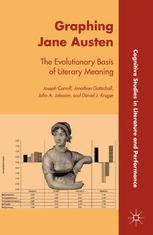
Graphing Jane Austen: The Evolutionary Basis of Literary Meaning PDF
Preview Graphing Jane Austen: The Evolutionary Basis of Literary Meaning
GRAPHING JANE AUSTEN Cognitive Studies in Literature and Performance Literature, Science, and a New Humanities Jonathan Gottschall Engaging Audiences Bruce McConachie The Public Intellectualism of Ralph Waldo Emerson and W.E.B. Du Bois Ryan Schneider Performance, Cognitive Theory, and Devotional Culture Jill Stevenson Shakespearean Neuroplay Amy Cook Evolving Hamlet Angus Fletcher Cognition in the Globe Evelyn B. Tribble Toward a General Theory of Acting John Lutterbie Trusting Performance Naomi Rokotnitz Graphing Jane Austen Joseph Carroll, Jonathan Gottschall, John A. Johnson, and Daniel J. Kruger Graphing Jane Austen The Evolutionary Basis of Literary Meaning Joseph Carroll Jonathan Gottschall John A. Johnson Daniel J. Kruger GRAPHING JANE AUSTEN C opyright © Joseph Carroll, Jonathan Gottschall, John A. Johnson, and Daniel J. Kruger, 2012. Softcover reprint of the hardcover 1st edition 2012 978-1-137-00240-2 All rights reserved. First published in 2012 by PALGRAVE MACMILLAN® in the United States— a division of St. Martin’s Press LLC, 175 Fifth Avenue, New York, NY 10010. Where this book is distributed in the UK, Europe and the rest of the world, this is by Palgrave Macmillan, a division of Macmillan Publishers Limited, registered in England, company number 785998, of Houndmills, Basingstoke, Hampshire RG21 6XS. Palgrave Macmillan is the global academic imprint of the above companies and has companies and representatives throughout the world. Palgrave® and Macmillan® are registered trademarks in the United States, the United Kingdom, Europe and other countries. ISBN 978-1-349-43377-3 ISBN 978-1-137-00241-9 (eBook) DOI 10.1057/9781137002419 Library of Congress Cataloging-in-Publication Data Graphing Jane Austen : the evolutionary basis of literary meaning / Joseph Carroll . . . [et al.]. p. cm.—(Cognitive studies in literature and performance) Includes bibliographical references. 1. Characters and characteristics in literature—Statistics. 2. English fiction—19th century—History and criticism. 3. English fiction—20th century—History and criticism. 4. Austen, Jane, 1775–1817—Characters. 5. Hardy, Thomas, 1840–1928—Characters. 6. Human behavior in literature. 7. Reader-response criticism. I. Carroll, Joseph, 1949– II. Title: Evolutionary basis of literary meaning. PR878.C47G73 2012 8239.80927—dc23 2011042318 A catalogue record of the book is available from the British Library. Design by Newgen Imaging Systems (P) Ltd., Chennai, India. First edition: May 2012 10 9 8 7 6 5 4 3 2 1 Contents List of Figures and Tables vii Acknowledgments xi Introduction 1 Part I Methods and Results Chapter 1 A User’s Manual 17 Chapter 2 Agonistic Structure Differentiated by Sex 35 Part II Implications Chapter 3 Determinate Meanings 59 Chapter 4 Sexual Politics 71 Chapter 5 Adaptive Function 81 Part III Case Studies Chapter 6 Jane Austen, by the Numbers 95 Chapter 7 Indifferent Tragedy in T he Mayor of Casterbridge 123 Conclusion 157 vi CONTENTS Glossary 177 Appendices 1 A Link to the Questionnaire 183 2 Characters for Whom Protocols Were Completed 185 3 The Distribution of Characters in Sets 199 4 Notes on Statistical Procedures 207 5 Results of Factor Analysis for Emotional Responses, Motives, and Mate Selection 219 6 Statistically Significant Results 223 Notes 227 Bibliography 241 Index 269 Figures and Tables Figures 1.1 Character success for protagonists and antagonists. 24 1.2 Character success in three female protagonists. 2 5 2.1 Motive factors in protagonists and antagonists. 40 2.2 Criteria used by protagonists and antagonists in selecting marital partners. 42 2.3 Personality factors in protagonists and antagonists. 4 5 2.4 Emotional response factors for protagonists and antagonists. 49 2.5 C irculatory system for a social ethos. 53 6.1 Motive factors in Austen’s antagonists, female protagonists, and male consorts. 102 6.2 Criteria for selecting marital partners in Austen’s antagonists, female protagonists, and male consorts. 103 6.3 Personality in Austen’s antagonists, female protagonists, and male consorts. 109 6.4 Personality in Austen’s female protagonists—the extraverts. 113 6.5 Personality in Austen’s female protagonists—the introverts. 113 6.6 Emotional responses to Austen’s antagonists, female protagonists, and male consorts. 116 viii FIGURES AND TABLES 6.7 Emotional responses to Austen’s less agonistically problematic female protagonists. 118 6.8 Emotional responses to Austen’s more agonistically problematic female protagonists. 118 7.1 Character success in Mayor of Casterbridge. 132 7.2 Emotional responses to characters in Mayor of Casterbridge. 134 7.3 Motive factors in Mayor of Casterbridge. 135 7.4 Criteria for selecting mates in M ayor of Casterbridge. 1 36 7.5 Personality factors for four main characters in Mayor of Casterbridge. 139 A.1 Numbers of characters in each agonistic set in each age group. 202 A.2 A positive correlation between wealth and power. 210 A.3 Scenario with small within-group variance, little overlap, and clear-cut sex differences. 213 A.4 Scenario with large within-group variance, significant overlap, and less clear-cut sex differences. 213 Tables 6.1 Number of Austen characters in the eight agonistic character sets (and the unassigned characters) 99 7.1 Number of respondents voting for each role assignment in Mayor 127 A.1 Distribution of codings among characters 2 00 A.2 Numbers of characters within each category of analysis 201 A.3 Number and percentage of characters in the agonistic character sets, and the unassigned characters 2 01 A.4 48 Characters with seven or more codings each 203 A.5 Factor analysis of emotional responses to characters—rotated component matrix 219 FIGURES AND TABLES ix A.6 Factor analysis of motives—rotated component matrix 220 A.7 Factor analysis of criteria for selecting long-term mates—rotated component matrix 220 A.8 Factor analysis of criteria for selecting short-term mates—rotated component matrix 221
